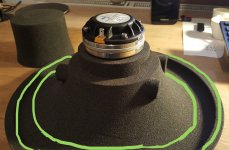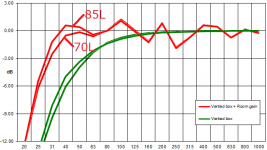Perhaps a damping solution would be to fill the “trough” (see image) with a self-leveling polyurethane used for filling cracks in cement
Just occurred to me that for the sake of experimentation, a product like duct seal could be used to fill the trough (see image). Duct seal remains pliable and will not adhere itself permanently and is easy to remove.
Attachments
In a passive speaker you are typically limited by the sensitivity of the woofer. Reaching around 90 dB/2.83V@m in overall sensitivity of the speaker would be a very good result. So there is really no need for such efficient midrange. It does no harm either but there's no "keeping up" with the CD.
Naturally, woofer(s) won't keep up with a comp. driver, but getting as close as possible is desirable imo.
Not because I'm a tube freak - I am not.
My current 2 way is 99 dB from about 100 Hz and it's a revelation in every respect compared to i.e. a smaller, 93 dB sensitive 2 way (double woofer + dome tweeter).
A few pages ago reference was made to passive radiators versus closed box versus bass reflex.
In my experience passive radiators are sub-optimal - especially at high SPL.
Closed box lowers efficiency, because it requires heavily constructed woofers > it's ok for bass, but sucks life out of the midrange.
I clearly prefer a large, low Xmax woofer in a semi-aperiodic bass reflex to the other 2 options.
Last edited:
In a passive speaker you are typically limited by the sensitivity of the woofer. Reaching around 90 dB/2.83V@m in overall sensitivity of the speaker would be a very good result. So there is really no need for such efficient midrange. It does no harm either but there's no "keeping up" with the CD.
This isn't always true. In the NS-15, I couldn't use a DE500 passively because it lacked sufficient output at 10kHz. I had to use the DE250 or go active. With a 12" this was not an issue, but with the 15" it was.
Of course, I was talking about full range speakers. That's what I do, or would like to do.
Last edited:
Closed box lowers efficiency, because it requires heavily constructed woofers > it's ok for bass, but sucks life out of the midrange.
That is not true. The passband efficiency of a woofer is unaffected by the enclosure design, hence no effect on the midrange. And you seem to be claiming that you can hear efficiency - how is that possible?
Of course, I was talking about full range speakers. That's what I do, or would like to do.
I didn't get that and now I am not sure what you are saying.
"In a passive full-range speaker you are typically limited by the sensitivity of the woofer." - this is a common experience. By a "passive full-range" I mean something like this - Salon2 | Ultima2 Loudspeaker Series, 4-Way Floorstanding Loudspeaker - 86.4 dB SPL with 2.83 V @ 1m (4 pi anechoic), not much, but that's how it is. Very few such speakers get above 90 dB. Of course there's no real need to reach 23 Hz@-3dB, I'd be happy with 30 - 40 Hz.
Last edited:
I get it now. Should have read it more carefully. I just assumed we were still talking about waveguide systems.
We are 🙂 That's not mutually exclusive. I want to make full-range passive speakers with waveguides.
The DE500 is among the best drivers with an all-Titanium diaphragm, but it lacks output above 10 kHz, which may pose a problem for passive crossovers.
I also considered its bigger brother, the DE980TN, but that one suffers from severe breakup resonances around 15 Khz.
I also considered its bigger brother, the DE980TN, but that one suffers from severe breakup resonances around 15 Khz.
I guess we are all getting old at about the same pace...
Ah yes!! But the starting point are very different!
The DE500 is among the best drivers with an all-Titanium diaphragm, but it lacks output above 10 kHz, which may pose a problem for passive crossovers.
I also considered its bigger brother, the DE980TN, but that one suffers from severe breakup resonances around 15 Khz.
15kHz, really?! Who cares! Yes, the DE500 (mylar) is my favorite CD if it can work.
That is not true. The passband efficiency of a woofer is unaffected by the enclosure design, hence no effect on the midrange. And you seem to be claiming that you can hear efficiency - how is that possible?
More specifically, I was referring to typical mid bass drivers for 2 ways.
It's possible to use a well-behaved subwoofer driver, but I personally prefer to use "lighter cones" above 500 Hz - which are usually more sensitive / efficient.
It just seems to better match the light diaphragm of a comp. driver. The mid range does sound more open/detailed, less muffled to my ears (and those of others).
I believe this aspect was discussed previously, so I leave it at "a matter of preference".
Last edited:
"In a passive full-range speaker you are typically limited by the sensitivity of the woofer." - this is a common experience. By a "passive full-range" I mean something like this - Salon2 | Ultima2 Loudspeaker Series, 4-Way Floorstanding Loudspeaker - 86.4 dB SPL with 2.83 V @ 1m (4 pi anechoic), not much, but that's how it is. Very few such speakers get above 90 dB. Of course there's no real need to reach 23 Hz@-3dB, I'd be happy with 30 - 40 Hz.
This is probably the best "typical" high-end loudspeaker of the last decade (and almost a half).
I don't care for deep bass either, because most of the music is in the midrange.
These kind of tower speakers usually require lots of amplifier current in order to get the lossy woofers moving.
Stereophile et al. started the -3dB at 20Hz mania long ago, which has prompted countless manufacturers to produce MOR high end tower speakers that basically consist of a bass array with a monitor speaker on top.
As far as I am concerned, the high end industry focuses too much on the reproduction of (sub) bass. This is often overkill in an average European living room.
Regarding bigger loudspeaker systems with pro woofers, it was rightly stated on another forum that -3dB around 50 Hz + room gain is a realistic target for a nice bass reproduction to approx. 30 Hz in many living rooms. Troels Gravesen suggested something similar and has posted a plot to illustrate this.
Attachments
Last edited:
It's nothing more than the LF extension / sensitivity / enclosure volume trade-off. You can always have only two of those at the same time, no matter what woofers you use.These kind of tower speakers usually require lots of amplifier current in order to get the lossy woofers moving.
There's probably some "sweet-spot" but I doubt it is anywhere above 90 dB/2.83V@m in the final sensitivity, unless you could tolerate huge enclosures.
Last edited:
Sure, but except bass/loudness correction on an amp this wouldn't fulfill my definition of a passive loudspeaker. I really want to keep it simple as much as possible. It may be just me, that's fine.
- Home
- Loudspeakers
- Multi-Way
- Acoustic Horn Design – The Easy Way (Ath4)

